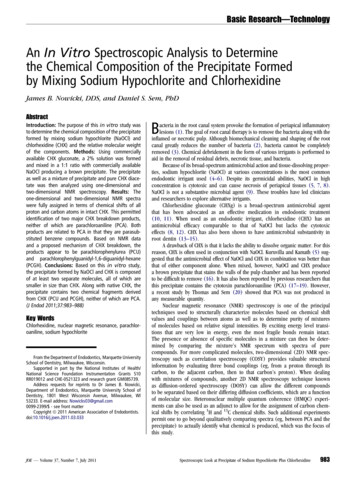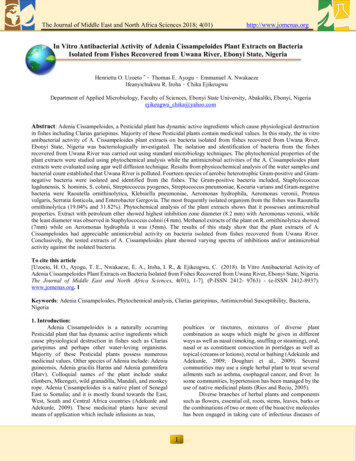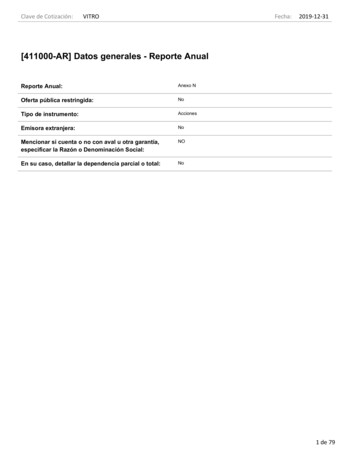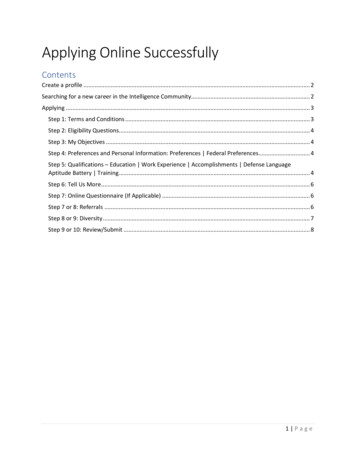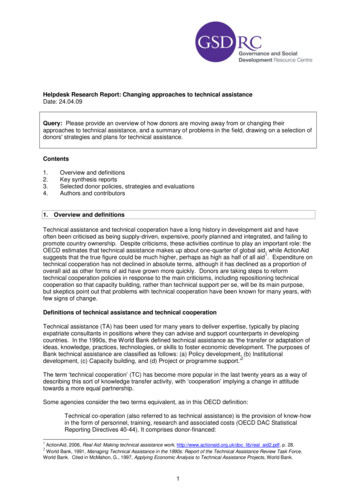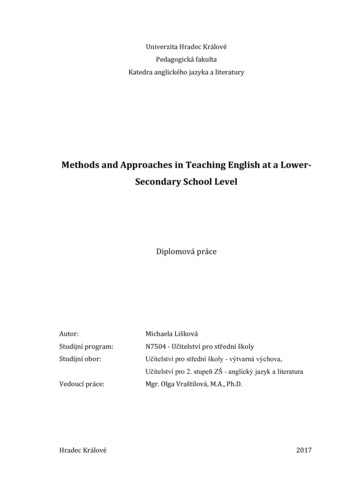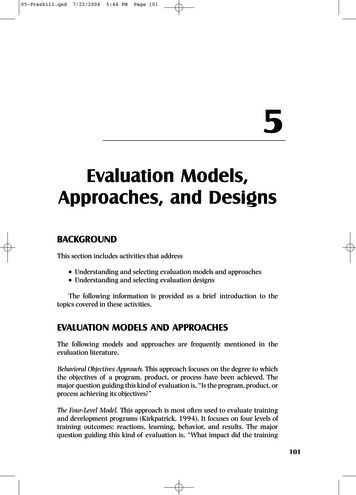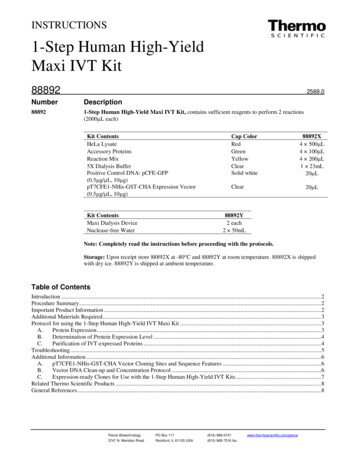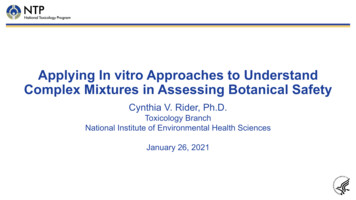
Transcription
Applying In vitro Approaches to UnderstandComplex Mixtures in Assessing Botanical SafetyCynthia V. Rider, Ph.D.Toxicology BranchNational Institute of Environmental Health SciencesJanuary 26, 2021
Mixtures risk assessment frameworkProblemformulationIs Data QualityAdequate?noNo quantitativeassessment; onlyqualitative assessmentyesWhole Mixture DataMixture ofconcernSufficientlysimilarmixtureComponent DataDo componentsinteract?Group ofsimilarmixturesnoComponentshave similarMOAsMixture RfD/C;Slope FactorComparativePotencyDoseAdditionAdapted from U.S. EPA (2000) Supplementary Guidance forConducting Health Risk Assessment of Chemical MixturesComponentshave azard Index
Current research at NTPBisphenol A &AnaloguesBotanical DietarySupplementsCell PhonesGlyphosate &FormulationsMedicines &TherapeuticsMoldNanomaterialsPolycyclic AromaticCompoundsSynthetic Turf/Crumb Rubber
Botanical dietary supplementsWidespread exposure relatively high doses Approximately 18% of adults in theU.S. ( 40 million people) usednonvitamin, nonmineral dietarysupplements in the past 12 monthsaccording to the 2012 National HealthInterview Survey US consumers spent 9.6 billion onbotanical dietary supplements in 2019 Recommended doses can be in therange of 100s - 1000s mg per dayFrom: Clarke et al., 2015, Trends in the Use of Complementary Health Approaches Among Adults: United States, 2002-2012.Smith et al., 2020. US Sales of Herbal Supplements Increase by 8.6% in 2019. HerbalGram, 127, 54-69.
NTP interest in botanicals NTP evaluates substances that are of public health concern There is little safety data on most botanicalsAloe vera Public concern about the quality and integrity of botanicals available in themarketplace NTP has received a number of nominations to study botanical dietarysupplements– National Cancer Institute (9), NIEHS (5), Private Individuals (3), FDA (2)
(Botanical) Dietary Supplement Regulation1994 Dietary Supplement Health and Education Act Amends the FD&C – created a regulatory framework for dietary supplements– Intent: Balance consumer access and consumer protection– Defines dietary supplements as foods and excludes them from consideration as foodadditives– Puts the burden of proof for risk on FDA (i.e., FDA has to prove that a dietary supplement isnot safe)– Clarifies labeling requirements– Requires new dietary supplement ingredients to be registered with the FDA– Specifies Good Manufacturing Practices for dietary supplements– Created the Office of Dietary Supplements at NIHFrom: Abdel-Rahman, 2011, Toxicological Sciences 132(2): 333-348.Dietary Supplement Health and Education Act of 1994. Public Law 103–417, 108 Stat. 4325-4335; October 25 1994.
History of safe use Consensus statements on historyof safe use:Discorides’Materia Medica, c. 1334– The safety of a botanical cannot bejudged based solely on a history offood use unless it can bedemonstrated that a comparablecomposition is ingested on a regularbasis across broad geographic anddemographic populations– In the assessment of a botanical, itis misleading to assume that ahistory of human use addresses allaspects of safety
Current NTP botanical portfolioCompleted Aloe vera nondecolorizedwhole leaf extract Bitter orange extract Ephedra (ma huang) Ginseng root extract Ginkgo biloba extract Goldenseal root powder Green tea extract Gum guggul extract Kava kava extract Milk thistle extract SennaOngoing Black cohosh extract Dong quai (root powder orextract) Echinacea purpureaextract Garcinia cambogia Usnea lichen Valerian root extractConeflowerEchinacea purpurea
Testing approach Identify knowledge gaps– Specific concern: Ephedra and cardiotoxicity– General: Lack of toxicity and carcinogenicity data Test article selection Study design (general)Ginkgo biloba– Animals: Male and female B6C3F1/N mice and Sprague Dawley rats (previously F344)– Exposure duration: 2-week, 3-month, 2-year– Dosing paradigm: typically oral gavage for botanical dietary supplements– Endpoints: clinical chemistry, hematology, genotoxicity, sperm motility and vaginal cytology,histopathology
History of NTP botanical researchBotanicalMale RatsFemale RatsMale MiceFemale MiceAloe veraClearClearNoNoGinkgo learClearSomeNoGreen teaNoNoNoNoKava KavaEquivocalNoClearClearMilk thistleNoNoNoNoSennaNot testedNot testedNoNoBitter orangeEphedraIncreased heart rate and blood pressureCardiotoxicityGreen teaCamellia sinensis
Sources of variationSource materialProcessingFinishedproductExposurePlant part (aerial,root, whole plant,leaf, seed)Extractionprocess*Manufacturingprocess*Dose (usepattern)ClimateSolventsExcipientsLength of dosingAdulterationCombination withother botanicalsLife-stageSoil conditionsSeasonPlant maturityContaminants(mold, nditionsCo-harvestedmaterials (otherplants, nal statusBackgroundgeneticsCo-exposures
NTP botanical workshopApril 26-27, 2016, NIH Campus, Bethesda, s/2016/index.html
Key challenges in assessing safetyIdentifying activeconstituentsHazard characterizationProduct rstandingADME ofbotanicals
Comparing across botanicalsSufficient similaritySufficient similarity phytoequivalenceTwo mixtures are similar enough that data from one of the mixtures (referencemixture) is transferable to the other (mixture of interest). ?Why is this important?There are thousands of products in the marketplace and we are not going to testall of them
Sufficient similarity frameworkPhase 1: Comparing reference tomixtures of interest within eachdatastreamPhase 2: Integrating acrossdatastreams and making an overallsimilarity call for each mixture ofinterest
Comparing the reference to the mixture(s) of interestSimple rules1. Generate data (any kind of data –chemistry, in vitro, in vivo) on thereference and mixtures of interest2. Multivariate statistical approaches toanalyze large datasets (PCA, hierarchicalclustering)3. Similarity judgmenta) Mixtures in the same group as the referenceare considered “similar”b) Mixtures in the most different group areconsidered “different”c) Mixtures in neither the most similar or the mostdifferent groups are considered “maybe similar”1ABCDE
Determining sufficient similarityLog10 Relative Fold mRNA ContentChemical dataBioactivity dataCYP2B6 (CAR)2.01.51.00.50.0-0.5-6-5-4-3-2-10Log10 Concentration (% v/v)SimilarDifferentCatlin et al., (2018). How similar is similar enough? A sufficient similarity case study with Ginkgo biloba extract. Food Chem Toxicol. 118: 328-339.
Black cohosh (Actaea racemosa)Natural variation, contamination, and adulterationBlack cohoshActaea racemosaYellow cohoshActaea podocarpaRed cohoshActaea ActaeaChinese cohoshSheng maActaea dahurica
Black cohosh (Actaea racemosa)In vitro assessmentClastogen positive controlAneugen positive control
Black cohosh (Actaea racemosa) What are we comparing?Reference BCE– Reference black cohosh extract – assessed in 90-day– Black cohosh extract unfinished samples– Black cohosh extract Standard Reference MaterialBCEformulatedproducts– Other cohosh extract Standard Reference Materials– Formulated black cohosh extract productsOther unfinishedBCE samples How are we comparing?– Chemical comparison Non-targeted chemistry – chromatographic profiles– Biological comparison In vitro assay– Human hepatocyte assay (AhR, CAR, PXR, FXR, PPARα)– Genotoxicity – micronucleus assay– Combining chemical and biological informationBCE SRMYellow cohoshRed cohoshChinesecohosh
Black cohosh (Actaea racemosa)Ryan et al., (2019). Evaluating Sufficient Similarity of Botanical Dietary Supplements:Combining Chemical and In Vitro Biological Data. Toxicological Sciences. 172:316-329.
HMGCS2 (PPARα)CYP2B6 (CAR)10-4-3-2-10-1-2-32Log10 Concentration (% v/v)1.00.50.0-4rifampicin 1.4-4-3-2-3-2-10Log10 Concentration (% v/v)-0.53omeprazole 2.5210-4-3-2-1-1-2Log10 Concentration (% v/v)ABCB11 (FXR)-1-1-2phenobarbital 1.3CYP3A4 (PXR)101.5CYP1A2 (AhR)Log10 Relative Fold mRNA Contentfenofibric acid 0.99Log10 Relative Fold mRNA Content2Log10 Concentration (% v/v)0Log10 Relative Fold mRNA ContentLog10 Relative Fold mRNA ContentLog10 Relative Fold mRNA ContentBlack cohosh (Actaea racemosa)10chenodeoxycholic acid 0.8-4-3-2-1-1-2Log10 Concentration (% v/v)0BCE 1BCE HBCE ABCE IBCE BBCE JBCE CBCE ZBCE DBCE AABCE EBCE ABBCE FBCE ACBCE GBCE AD0
Comparing chemical and bioactivity similarityStrength of evidenceNontargeted chemistryPHH gene expressionGenotoxicitySimilarity scoreA-1110.3Visual interval 0-110
Black cohosh (Actaea racemosa)Key points Micronucleus induction and megaloblastic anemia are the critical endpointsidentified in animal studies This finding was replicated in human cells (not a rodent-specific finding) An aneugenic mechanism was identified, which indicates there is likely athreshold effect All cohoshes induced micronucleus formation (not specific to subset of blackcohosh samples and active constituent has not been identified) The next step is to identify the constituent(s) responsible for the genotoxiceffect
Identifying active constituentsActive extractExtractionBioassaySeparationBlack cohoshChemical StructureIsolation/IdentificationBioassayActive fractionRoberts et al., 2019. Food and Chemical Toxicology. 124: 431-438.Smith-Roe et al., 2018. Environmental and Molecular Mutagenesis 59:416-426.
Botanicals in Tox21 Toxicology in the 21st Century (Tox21) is a federal collaboration between EPA,NIH (National Center for Advancing Translational Sciences and the NationalToxicology Program) and the Food and Drug Administration Phase 2 involved evaluating the 10k chemical library (8193 unique chemicals)in over 75 quantitative high throughput assays measuring stress response andnuclear receptor activity Mostly focused on single chemicals, some defined mixtures includedCan the Tox21 platform be used to evaluate botanical dietarysupplements and other complex mixtures?
Botanicals in Tox21In vitro ity-hepg2-flor10.5710Hubbard et al., 2019, Using Tox21 High-Throughput Screening Assays for the Evaluation of Botanical and Dietary Supplements. Applied In vitroToxicology 5(1):10-25
Botanical safety“ as with other commodities that the agency regulates, it’s critical that FDA continue towork closely with our partners in industry to achieve our primary goal of protecting publichealth and safety. As the dietary supplement industry develops new products andingredients, advances new delivery systems and innovates in other ways, the FDA must domore to leverage its existing resources and authorities to evaluate these products. Thisrequires collaborative research and a shared understanding. I’m pleased to announce thatwe’ve recently created the Botanical Safety Consortium, a public-private partnership that willgather leading scientific minds from industry, academia and government to promotescientific advances in evaluating the safety of botanical ingredients and mixtures in dietarysupplements. This group will look at novel ways to use cutting-edge toxicology tools,including alternatives to animal testing, to promote the goals of safety and effectiveness weshare with consumers and other stakeholders.”
Botanical Safety ConsortiumA public-private partnership aimed at developing a toolbox of in vitro and in silicoassays and approaches for evaluating botanical safety
Objective 2.3: Botanical Safety ConsortiumObjectives
Challenges Better understanding the transition from adaptive toadverse responses in sensitive in vitro systems to identifyreal safety concernsMolecularInitiatingEvent Developing recommendations for chemical analysis ofcomplex botanical ingredients and productsKey Event Achieving an appropriate level of biological coverage toidentify likely toxicity targets while maintaining amanageable testing platform Identifying active constituents and measuringconcentrations in in vitro assessments to aid in translatingfindings to humans and comparing across products Refining complex mixture read-across methodsKey EventAdverseOutcome
Conclusions In vitro assays combined with non-targeted chemical analysis wereuseful in evaluating sufficient similarity of complex mixtures In vitro assays can be incorporated into bioassay-guided fractionationapproaches to identify active constituents in complex mixtures Botanicals evaluated in Tox21 assays point to both challenges andopportunities for complex mixtures The Botanical Safety Consortium is actively working to develop a toolkitof in vitro assays and recommended framework for assessing botanicalsafetyTurmericCurcuma longa
Acknowledgements Chemistry– Suramya Waidyanatha– Brad Collins– Esra Mutlu– MRIGlobal– Battelle Black cohosh– Stephanie Smith-Roe– ILS Echinacea– Kristen Ryan– Mimi Huang Ginkgo biloba extract case High throughput screeningstudyof botanicals– Stephen Ferguson– Troy Hubbard– Scott Auerbach– Jui-Hua Hsieh– Sreenivasa Ramaiahgari– NCATS– Julie Rice– Paul Dunlap– Arun Pandiri Botanical SafetyConsortium– Michelle Embry– Connie MitchellGarcinia cambogiaGarcinia gummi-gutta
Jan 26, 2021 · Applying In vitro Approaches to Understand Complex Mixtures in Assessing Botanical Safety Cynthia V. Rider, Ph.D. Toxicology Br
